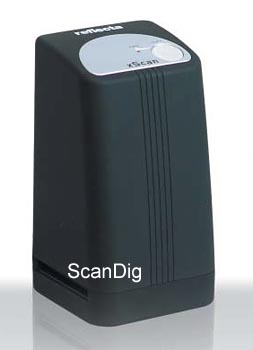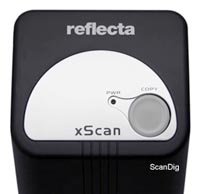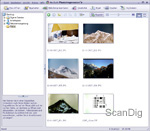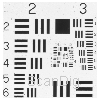Test report film scanner Reflecta xScan
By the end of October 2007, just in time for the Christmas business, Reflecta introduced with xScan a real novelty in the field of film scanners to the market. The xScan is the first film scanner, which has a CMOS-chip and not a CCD-line. This means a 35mm-slide or negative is being scanned in one shot and not line by line through the CCD-line-sensor. In principle the xScan is some kind of stationary digital camera, which simply photographs the inserted film.
The XScan was replaced by the successor X2-Scan in September 2008. Our test report is to show, what quality the xScan actually offers and whether the device can compete against scanners which work the conventional way. We've tested the device in December 2007, very soon after the introduction on the market. We won't add later information about possible changes in the hardware or the software to our test report.
Equipment, accessories and technical data of the film scanner

The Reflecta xScan is delivered with little but complete equipment. Thus one receives additionally to the scanner a film holder for a 35mm film strip with up to 6 pictures and a film holder for up to 3 framed 35mm slides. There's also an included CD with the Twain driver software, as well as the picture-processing and -viewing program ArcSoft PhotoImpression 6. Operating instructions in German and other languages come with it too. The USB connection cable is firmly connected with the device - so one can't exchange it. That's already it about the provided accessories - but one doesn't need more. A power cable or a power supply is not needed, since the scanner is receiving the power through the USB-connection.
According to the manufacturer's description the scanning time for a picture is just one second. Thus this mini-scanner is more than 100 times faster than some professional film scanner. The technical data (24 bits color depth, 5 megapixels resolution, USB 2.0 connection) clearly sound like a digital camera. There were already numerous attempts and solution possibilities in the past years to photograph images off slides using digital cameras. With the xScan Reflecta brought such an integrated, complete solution to the market.
The price is sensationally cheap for such a fast film scanner, but the technical data given by the manufacturer don't suggest professional image quality: 4 megapixels remain when scanning a realistic portion of the picture with 1800 dpi. The maximum density of 3.0 Dmax means a density range of 2,5; that's too little to get the details in shaded and bright parts. An automatic dust and scratch correction, such as ICE or iSRD, is of cause technically impossible, too.

The Reflecta xScan is therefore no scanner for professional archiving of slides or negatives, but rather a device to quickly transfer own pictures into the PC in order to view them or to publish them on the Internet. One can conclude this already by analyzing the technical data.
Installation and starting
The installation of the Reflecta xScan works like with most other USB devices. First the driver software must be installed. To do so, one simply inserts the provided CD into the drive and selects the driver installation. Afterwards one can install the included ArcSoft PhotoImpression 6. This also happens by a simple click on the corresponding menu option in the installation window.
Before connecting the scanner through USB 2.0 to the computer, one must remove the CD from the drive - otherwise the initialization of the scanner doesn't work and with the attempt to scan an error message will appear. If the CD is removed from the drive and the scanner is connected, a window appears with the message that new hardware was found. Here one has to click on "install driver automatically" - and then exactly that directly happens.
Switching the scanner on and off is not possible. As soon as the connection with the computer is established, the power-indication lamp is lit and the device is ready. When this step is done, one can start scanning. With the first start of the scanning software the scanner is being calibrated, therefore one must make sure that there is no film in the scanner yet.
Scanning framed slides
The film holder for framed slides can take up to three slides at the same time. They have simply to be placed side-correct in the opened holder and then the cover needs to be closed. The film holder makes a quite instable impression, but is besides that easy to handle.
The equipped holder has to be pushed from the right into the scanner. The front has small grooves which ensure that the holder locks in a correct position - this guarantees that the film material is in the right place for scanning. The film holder can only be moved in one direction, from the right to the left. So if the holder gets pushed too far, one must pass it completely through and insert him again. That's of course annoying if one pushed once too far; so why this restriction?


One can start the scanning software only through the Twain interface of a corresponding program. This can be the provided Arcsoft PhotoImpression, or e.g. a picture processing program such as Adobe® Photoshop® Elements. However for somehow comfortable scanning the provided software has to be used: only with it one can specify, whether the inserted film is a slide, a color-negative or a black/white film, as well as specify resolution and color depth. With the Twain-import through Photoshop® one receives a picture, which just shows the photographed film. If this is a negative-film, then we have also a negative picture on the monitor.
All adjustments, which can be made with PhotoImpression before the scan, can of course be also done with Photoshop® afterwards - this proceeding is not exactly comfortable, but it makes no difference in the quality: PhotoImpression also doesn't make anything different than to correct the image from the film with an automatic procedure and to convert it into a positive if necessary. The here possible adjustments of resolution (one can select between 1800 and 3600 dpi) and color depth (24 or 48 bits) lead also just to an afterwards interpolation. The hardware works exclusively with 1800 dpi and 24 bits.
A slide-scan with PhotoImpression takes place like this: first one clicks on "open picture" and selects "get image from scanner". Here one chooses the desired display format (TIF or JPG), selects the wished destination folder, sets the film-type for slide and specifies resolution and color depth. Due to the above mentioned reasons it is advisable to leave the two last-mentioned adjustments on 1800 dpi and 24 bits. A selection of the scanning area is not possible - always the complete slide will be scanned.
Clicking on "get/capture" makes a window with a live-picture of the inserted film appear. If one made sure that the correct picture is inserted, then one clicks on "Snapshot" or presses the "Copy" key of the device. The scanned picture now appears at the top margin of the window. Now one can push the film holder further and make a snapshot of the next slide, until all slides which should be scanned are done. Of course in between the film holder can be re-equipped with new slides. By one click on "transfer", the pictures are being stored in the before chosen target directory, which immediately opens in PhotoImpression where the contents are being displayed as miniature views.
Scanning negative-strips


The film holder for negative strips can take a film strip with up to six pictures. Above and beneath each picture are guiding-pins, which go through the perforation and which are holding the filmstrips fixed in the proper position.
The proceeding when scanning negatives doesn't differ from scanning slides, except that when using PhotoImpression the film-type has to be set on "negative" before the scan. The filmstrip-holder has also grooves at the front, which ensure its correct positioning in the scanner.
The scanning of longer film strips with more than 6 pictures or whole film rolls is not possible with the included film holders, since they are not designed in a way which would allow film material to hang over. APS films also can't be inserted into the filmstrip-holder.
The included software
The software equipment of the Reflecta xScan is limited to the driver software and ArcSoft PhotoImpression 6. This program is a small but fine tool for the simple management, viewing and processing of your photos. One can make with it slide-shows in a simple manner, rotate pictures, sort, print, send by email, rename and convert in batch processing mode, add frames and clip arts to the pictures and do some simple picture processing.

For this there is a small selection of picture processing functions. These are divided into different groups. In "adapting" one finds tools e.g. for adjusting brightness, contrast and sharpness, color corrections, the automatic or manual red-eye- removal and the cropping and free rotation of pictures.

The tools-group "retouching" covers the tools repair brush, clone stamp, lighten/darken, smudge, sharpen and soften, which are all adjustable in brush size and intensity. Furthermore there is a paintbrush, a function for drawing lines as well as an eraser. Under the group "clipboard" you will find selection tools, with which you mark parts of the picture, copy them into the clipboard and insert them from there again into any picture.
ArcSoft PhotoImpression 6 is simple to handle and it's quite fun to spice up the photos with this software. One can of course not compare the volume of functions with Adobe® Photoshop® Elements, but this software alone would already costs nearly as much as the Reflecta xScan including PhotoImpression.
Picture quality
Let's now get to the point of our test, which probably interests all of us the most. How good are the pictures which the Reflecta xScan produces?
One thing upfront: one cannot expect that a scanner, which works similar like a simple digital camera, meaning simply takes a picture of the target, delivers as good results as a real scanner, which scans the film line by line. The Reflecta xScan acts like a webcam. One sees on the monitor a live-picture from the installed camera and can make a still-picture by pushing a button. The picture result is accordingly: to the edges the picture brightness decreases strongly, with dark motives strong noise can be seen, and with uniform color surfaces beside the noise an additional image disturbances in form of striped patterns becomes very unpleasantly visible.

The contrast range of the Reflecta xScan is very narrow. In darker picture portions, where high-quality film scanners still capture details without problems, there's nothing recognizable and bright picture areas tend to overexpose too.
In a resolution test using the USAF test chart one can just about differentiate the horizontal lines of the element 4.6 and the vertical lines of the element 5.1. This means a medium resolution of approximately 1500 dpi. That's 83% of the nominal resolution. Compared in relation to the exaggerated specifications and the effective resolutions of many film scanners, this is proportionally seen a good value. Considering the fact that the nominal resolution of 1800 dpi is anyway already very small, it would have been however nice, if the xScan would had reached at least this resolution.
If one makes a scan with Reflecta's xScan using the highest resolution of 1800 dpi, then one receives a picture with an effective resolution of 1500 dpi. This means that the scan of a 35mm format (36x24 mm) has 3 megapixels of picture information. Good film scanners retrieve 10-20 megapixels from 35mm images.


The absence of a dust and scratch correction is system-determined and affects the image quality likewise negatively: even on carefully cleaned targets a lot of disturbing dust and fluff is visible in the picture. And who would like to extensively clean his films before each scan, when using a scanner, which is supposed enable one to work simply and quickly?
Based on the photos shown here you can judge for yourself the quality which the xScan delivers. The picture in the left shows a scan made with xScan, the picture in the right a scan made with the film scanner
Nikon CoolScan 5000 ED (top model among the film scanners, which we also use for our offered scan-service) - both without making any corrections in the scanning-software, which wouldn't be possible with the xScan anyway.
As one can see, the Reflecta xScan isn't suited for archiving one's valuable picture material or to make scans for high-quality photo prints. Its proper field of use is absolutely and clearly the digitization of film material for the fast transmission by email, e.g. in order to send snapshots from the last vacation to one's friends, or to get the film material for picture selection into the computer and to later enlarge the selected pictures or to have them scanned properly.
Scanning speed
Since the Reflecta xScan photographs the target-image and does not scan it line by line, the scanning speed would have to be system-dependently much higher than with conventional scanners. The production of a snapshot takes indeed (as claimed by Reflecta) just about 1 second. The production of a full image-file however, which takes place after clicking on "transfer" in the scanning window, takes depending on the computer as well as on the adjusted resolution and color depth, then again approximately half a minute. A normal film scanner can manage this too when using this resolution.
| Scanning single pictures |
Duration |
| Snapshot |
0:01 min |
| Transfer 1800 dpi 24Bit |
0:21 min |
| Transfer 1800 dpi 48Bit |
0:26 min |
| Transfer 3600 dpi 24Bit |
0:24 min |
| Transfer 3600 dpi 48Bit |
0:39 min |
There is no difference in the scanning speed between processing slides or negatives.
We achieved the above scanning times on a computer with 3 GHz Pentium processor and 2 GB main memory. The scanner was connected through an USB 2.0 connection. The transfer times increase substantially, if one uses a much slower USB 1.x connection instead of an USB 2.0 one.
Summary, result
The chapter about the picture quality of the Reflecta xScan showed that this "scanner" is not suitable for digitization of film material with the purpose to archive it or for the production of image files for high-quality photo-prints.
It is rather a nice "toy" for people, who want to transport pictures from the film easily into the email outbox, into a web page or to an on-screen overview in the computer, or who simply enjoy unusual technology. The low price can also be an important factor for the decision to chose this device. However the Reflecta xScan can't and doesn't want to replace a real film scanner.
Buying a film scanner
Please, feel free to visit our online shop - it's the only shop on the Internet which is fully specialized on film scanners and accessories! We can provide you with any film scanner at an extremely attractive price and we also can supply you with accessories such as film holders or optional adapters.
Back to the film scanner tests index
|